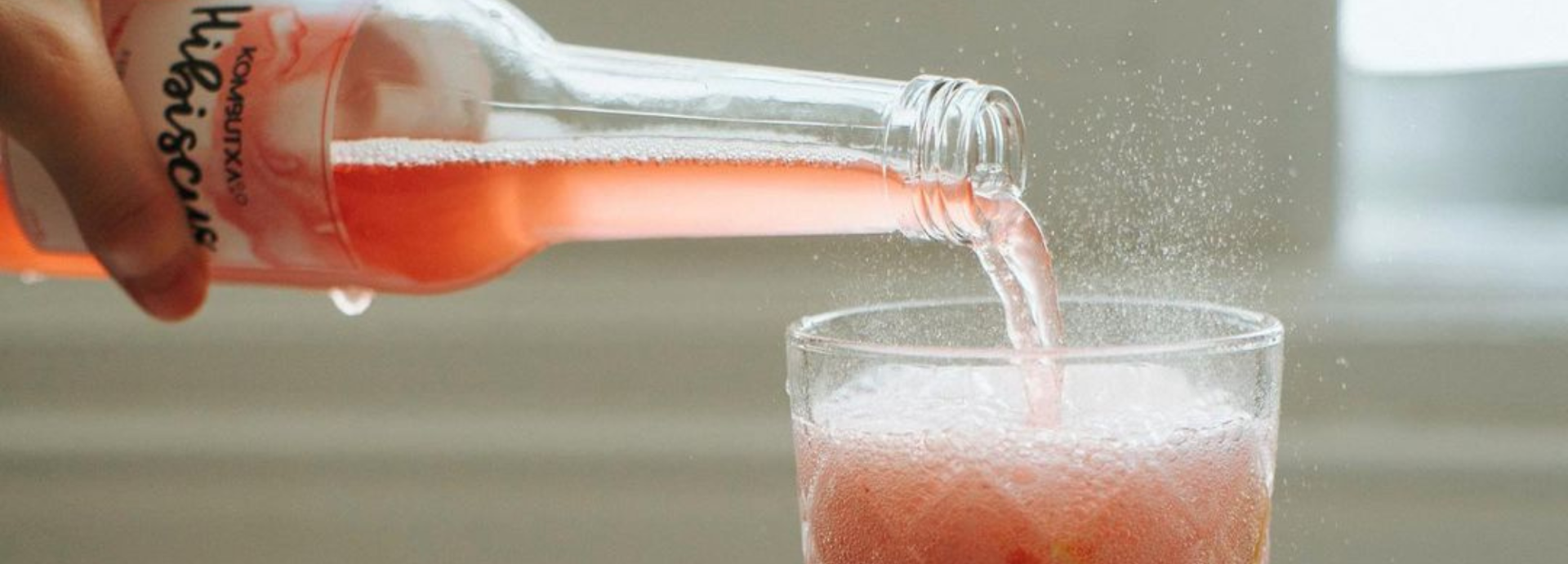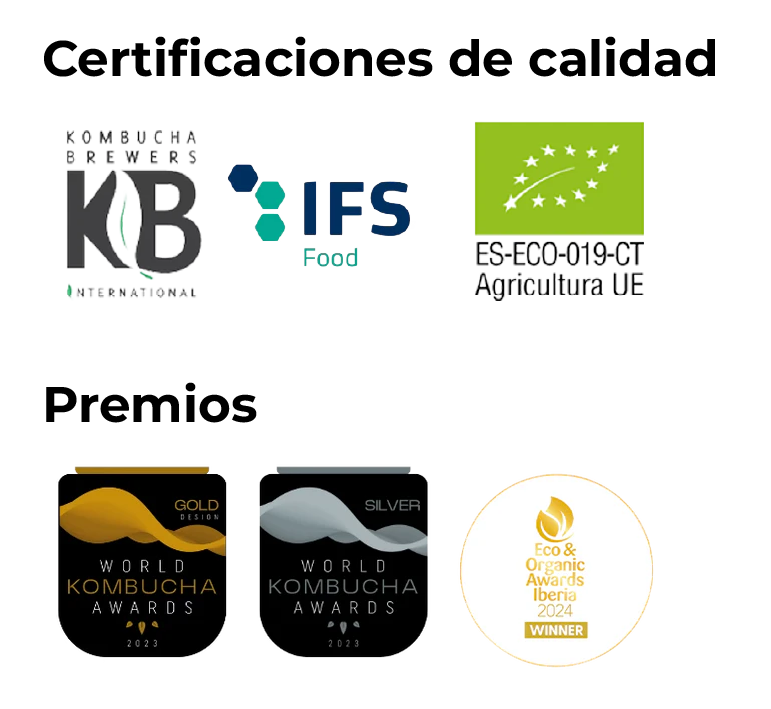Is kombucha carbonated?
The answer is it depends. It depends on the type of process that has occurred. We tell you.
When traditional kombucha fermentation is done, from sweetened tea brew and the SCOBY , it is done in an open container. Even if we cover it with a cotton cloth to keep out insects and protect it from dust, the gas produced by the yeast (carbon dioxide) is not trapped in the liquid. If you try this kombucha you will notice that it is not carbonated.
Kombucha is carbonated if, once bottled, it is allowed to ferment at room temperature.
When kombucha is bottled, it is sometimes used to flavor it with fruit juices. If you store this freshly bottled kombucha in the refrigerator, gas will not be produced, since the yeasts are inactivated by the cold. Now, if you let it rest at room temperature, the active yeasts inside the bottle will continue to ferment. On the one hand, the sugar that remains from the beginning and, on the other, the sugar provided by the fruit juice.
For kombucha to be carbonated we need three variables:
- that has live yeast
- that has residual sugar so that the yeasts can produce CO2
- that the temperature is above 18º
To prevent the kombucha from continuing to ferment in the bottle, there are three solutions:
- pasteurize : There are other brands of kombucha that kill yeast and bacteria and thus prevent fermentation from continuing. The problem: that the probiotic properties provided by the yeasts and bacteria normally present in kombucha are lost.
- low residual sugar : this is the case with Mun Kombucha . Our kombucha has just enough sugar to generate a little bubble, CO2. Once the gas is generated, there is no more sugar left to continue fermenting, which is why Mun Kombucha is stable in the environment and is not pasteurized.
- Store kombucha in the refrigerator : This is the solution many kombucha brands follow. If the kombucha has live yeasts and a lot of sugar and is kept at room temperature, fermentation will continue until the sugar is used up. Above 2g/100ml this second fermentation can cause the bottle to burst. Hence, the solution that manufacturers adopt with kombucha with a high level of sugar is to keep it cold.
¿Tiene gas Mun Kombucha?

Por regla general, SÍ, pero como todo, hay matices. En Mūn elaboramos siguiendo a pies juntillas el método tradicional que tiene más de 2.000 años. Utilizamos solo ingredientes absolutamente naturales, de primerísima calidad y 100% ecológicos. Y no añadimos gas carbónico. El gas presente en nuestras bebidas es natural y se genera durante la segunda fermentación de nuestras bebidas. ¡Por esto no aparece en la etiqueta! No es un ingrediente, se produce de manera absolutamente espontánea si se dan las circunstancias para que así sea.
En la primera fermentación de la kombucha que hacemos en depósitos, dejamos que el CO2 producido por las levaduras se vaya, perdiéndose. Esta primera fermentación es importante que sea en presencia de oxígeno, ya que, si no, las bacterias no pueden funcionar y llevar a cabo su propósito.
Una vez consideramos que esta primera fermentación ha terminado, es cuando procedemos a añadir zumos de frutas (como manzana, granada, limón), zumos de raíces (jengibre o cúrcuma), zumos de hojas (menta o albahaca) o zumos de verduras (pepino o remolacha).
Esta kombucha saborizada se envasa en botellas de vidrio que se dejan reposar. Cómo no pasteurizamos la kombucha, las levaduras se encargarán de fermentar los azúcares presentes y producirán este CO2 que se traducirá en finas burbujas.
In the first fermentation of the kombucha that we make in tanks, we let the CO2 produced by the yeast leave and be lost. This first fermentation is important to be in the presence of oxygen, since, if not, the bacteria cannot function and carry out their purpose.
Once we consider that this first fermentation has finished, we proceed to add fruit juices (such as apple, pomegranate, lemon), root juices (ginger or turmeric), leaf juices (mint or basil) or vegetable juices (cucumber or beet).
This flavored kombucha is packaged in glass bottles that are left to steep. Since we do not pasteurize the kombucha, the yeasts will be in charge of fermenting the sugars present and will produce this CO2 that will translate into fine bubbles.
Do all Mun flavors have the same bubble?
No. In the case of the Natural or the Original , depending on which range we are talking about, as a very long first fermentation has occurred, there is practically no residual sugar. This variety, since it does not contain any fruit juice, does not have that extra sugar so that the yeasts can make the bubble. In this way, Mun Kombucha Original , or Mun Premium Kombutxa Natural , develops a very fine bubble over time. But the usual thing is that there is almost no bubble.
The other varieties are more likely to have gas, but it also depends on other factors. As we have already indicated, temperature influences the formation of the bubble, but we have also seen how in winter the yeasts are more dormant and gas production is lower.
Our production is completely natural, so it is normal that from one batch to another there is a certain difference in the gas produced. But don't worry, the benefits of drinking kombucha are independent of the bubble, since what is important is the process that occurred during the first fermentation in our tanks.

¿En qué condiciones se produce la burbuja dentro la botella?
Como ya hemos explicado, las levaduras son las responsables de transformar los azúcares en CO2. Para que esto suceda, tiene que haber una población lo suficientemente activa y darse las condiciones de temperatura favorables. Esto es, a partir de los 18º. Por debajo, la burbuja se crea muy lentamente.
Esto es lo que sucede en invierno. Las levaduras quedan adormecidas por la baja temperatura ambiente, lo que hace que la producción del gas sea más lento de lo habitual. Por esto, si alguna vez tienes un lote de Mun Kombucha que tiene poco gas, las puedes dejar a temperatura ambiente, cerradas, para favorecer este proceso natural.
¿Se puede añadir gas a la kombucha?
De poderse se puede. Es lo que hacen otras marcas de kombucha. Para no depender de un proceso natural, añaden gas carbónico y tema zanjado: así aseguran que sus kombuchas siempre sean exactamente iguales. Es por esto que siempre verás que estas kombuchas más procesadas siempre tienen el mismo punto de gas, a diferencia de Mun Kombucha. Dejar actuar a la naturaleza y no marcarle un camino a seguir o desvirtuar su función es lo que tiene: cada variedad y, es más, cada lote, son distintos y nos encanta que así sea.
Can you add carbonation to kombucha?
If you can, you can. This is what other kombucha brands do. In order not to depend on a natural process, they add carbon dioxide and ditched matter: this way they ensure that their kombuchas are always exactly the same. This is why you will always see that these more processed kombuchas always have the same carbonation point, unlike Mun Kombucha. Letting nature act and not setting a path for it to follow or distorting its function is what it has: each variety and, what's more, each batch, are different and we love that this is the case.
Is carbon dioxide healthy?
The added carbon dioxide can cause problems in people who suffer from digestive problems such as dyspepsia, gastritis, gastroesophageal reflux or irritable bowel syndrome. In the case of kombucha, which if it is made according to the traditional method and following its precepts, it will not have added gas but rather the gas generated during fermentation, the digestion aid factor to which natural probiotics contribute must be taken into account. the enzymes present in the drink. If you are not sure if it will suit you, you can always let the gas disappear, add ice and let it rest or mix it with water, for example.
It should be taken into account that in the case of added carbon dioxide, such as soft drinks or kombuchas that choose to add it to the mixture to make a uniform product, the benefits mentioned above are not present and could aggravate or even will create some digestive problems.
Does the use of carbon dioxide to add carbon to kombucha have to be labeled?
Well yes. According to REGULATION (EU) No 1169/2011, carbon dioxide is an additive considered an ingredient and therefore must appear in the list of ingredients on the label.






